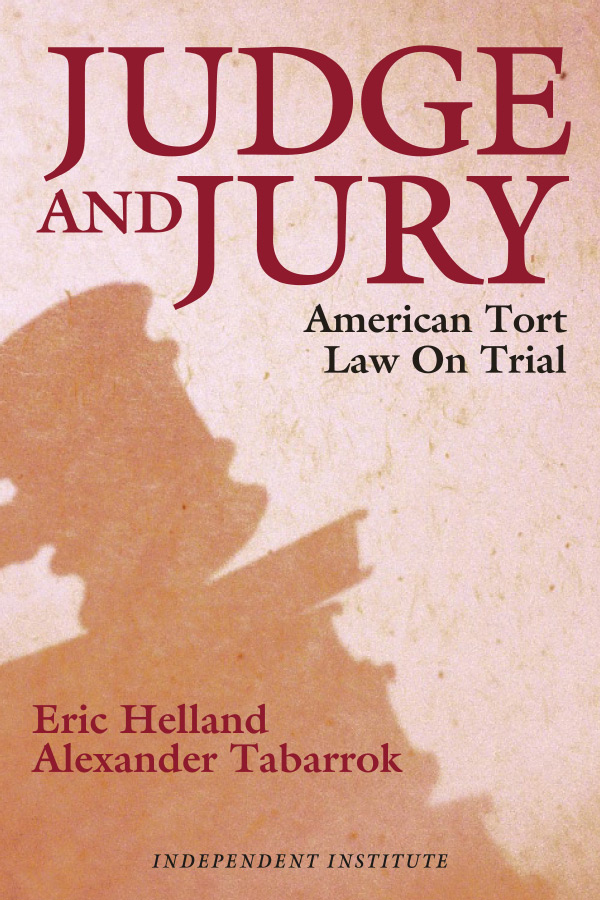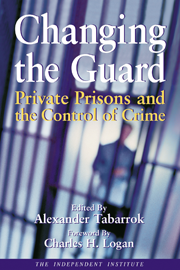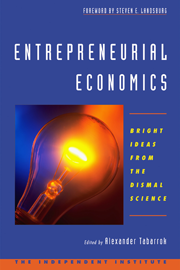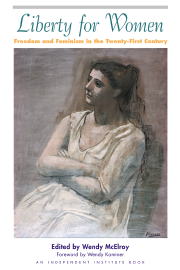Alexander Tabarrok
Research Director, The Independent Institute
Testimony before the Little Hoover Commission
State of California
Sacramento, California
May 24, 2001
I have been asked to speak about the integration of immigrants and in particular about the role of the state government in integrating immigrants. I would like to begin by pointing out that integration is not always desirable. Immigrants, for example, have much lower rates of crime than do natives and they have especially low rates relative to what one would predict given their education and income levels (Butcher and Piehl, 1998). If natives had the same institutionalization rate as immigrants our jails and prisons would have one-third fewer inmates. In this case, it is unfortunate that immigrants eventually do assimilate to U.S. levels of crime, although we are lucky that assimilation with respect to crime takes some time. We can hope that in the long-run the presence of immigrants will in fact reduce the native level of crime. Immigrants also compare well with natives on a number of other characteristics. The strength of Hispanic families relative to those of natives is notable, for example, as are the high rates of entrepreneurship among Korean, Chinese and Cuban immigrants (Portes and Zhou, 1999).
Bearing in mind these and other qualifications it is nevertheless true that in many respects integration is desirable. Proficiency in the English language is the single most desirable aspect of integration. I will say more about language policy in a moment, but I’d like to speak first and more generally about education. Education is important not only for immigrants and their children but also for natives. Immigration is most controversial to the extent that low-skilled immigrants reduce the wages of low-skilled natives. Education helps on both sides of this equation. The more educated the natives are the greater the benefits of immigration and the more educated immigrants are the greater the benefits of immigration.
What role can the state play in this process? Unfortunately, the state is already playing too large a role in the provision of education, with notably poor results: SAT scores are down, U.S. students perform poorly compared to those in other nations, we are spending more on education than ever before and we are getting less (Vedder 2000). Astoundingly, the high school dropout rate in California is 32 percent with an immigrant high school drop out rate of around 45 percent. And recall that high school dropouts have higher rates of unemployment, lower wages and greater criminal propensities than those who complete high school. Even supporters of government schools such as Governor Gray Davis call them “a disaster.” In Oakland, where I live, 70 percent of the students are not reading at grade level. Oakland superintendent Dennis Chaconas is right when he says that “the students are great, but the system is failing them.”
As a result of the failure of the government schools, the amount of home schooling is exploding—well over one million children are now being home schooled in the United States (National Home Education Research Institute, NHERI). As another indication of how eager parents are to have their children escape the public schools note that in 1999, the Children’s Scholarship Fund, a private charity set up to help children pay the tuition at private schools, offered 40,000 scholarships but received over 1.25 million applications. The demand for private education is all the more amazing when one recognizes that by design the scholarships will only pay about half of the tuition costs. The rest, typically around $1000, must come from participating families.
The CSF inspired many other groups and individuals to begin offering scholarships to private schools. The Independent Institute has one such program which this year will award about 200 scholarships. Unfortunately, as with the CSF we have many more applications than scholarship recipients. The Florida legislature recently passed a bill to give tax credits to corporations that donated money to scholarship programs for private schools—this is an excellent idea and one that California should investigate.
Contrary to much public belief, private schools are on average much less costly than public schools and private schools serve many low-income immigrant children. The Catholic schools in the Archdiocese of Los Angeles, for example, enroll over one hundred thousand students. If the Archdiocese schools were government-run it would be California’s third largest school district. In the 1999-2000 school year 28 percent of L.A. Catholic school children received federally-subsidized free or reduced-price meals and fifty-one percent of Archdiocese schools are located in urban or inner-city neighborhoods. A full 13 percent of students, by the way, are non-Catholic and in some schools the non-Catholic enrollment approaches 50 percent (Dawson and Helland, 2001). The Catholic Education Foundation last year gave tuition awards to nearly 5000 students in the archdiocese.
Parents must sacrifice to pay private school tuition on top of taxes but they do so on behalf of a better education of their children. Academic research corroborates the wisdom of parent choice. Students in private schools are better educated, more likely to graduate high school and more likely to attend college than similar students in the government schools (Colman, Hoffer, and Kilgore 1982, Evans and Schwab 1995; for many further references see also Dawson and Helland 2001; Vedder 2000 and Coulson 1999 for an overview examining other countries and time periods). To give one figure, Catholic schools, the best studied of the private schools, do a phenomenal job of reducing the high school drop out rate. Catholic schools raise the high school graduation rate of all students but they have an especially positive affect on those students most likely to drop out of the public schools, low-income students, students from single-parent families and students from families where the parents have a limited educational background (Evans and Schwab 1995).
Government schools are failing to teach students who have English as a first language—throw at them the problem of teaching Limited English Proficiency students and the situation goes from bad to worse. Immigrants and the children of immigrants from non-English speaking countries face special challenges in learning English, adjusting to American culture and at the same time trying to learn new skills that will serve them well in the American job market. California’s one-size-does-not-fit-all government school system does not serve these children well. A particularly notable example is California’s bilingual education policy. I am not going to enter here into the debate over whether bilingual education helps or hinders LEP children. What I do want to point to is the absurdity of a system that takes decisions away from parents and individual schools and places them in the hands of politicians, education bureaucrats and voters. For twenty years we had a policy in California of encouraging and even mandating bilingual education for all LEP students in all schools. Now following, Proposition 227, we have a policy that severely restricts bilingual education again for all LEP students in all schools.
It is evident that our politicized system has no room for diversity, experimentation or competition and as a result we are faced with a choice of illiteracy in one language or illiteracy in two. What is needed in place of this is a larger role for private schools and for parent choice—a process that can and should be encouraged by providing tax credits to those who donate money to private scholarship funds by offering education vouchers or tax credits that are available to all parents and finally by privatizing the public schools.
Creating a better education system, which means introducing more private initiative into the education process, is the best approach to raising the benefits and lowering the costs of immigration. I will touch on just a few other areas briefly. By mandating that all contractors with the state pay union wages, laws such as the little Davis-Bacon Act make it difficult for immigrants to compete with better-established firms for government contracts. In addition to raising costs to the state, this reduces the integration of immigrants into the economic mainstream. It’s revealing to note that one of the reason these laws were passed in the 1930s was to make it more costly to hire African Americans, the main source of cheap labor at that time. The discriminatory impact of these laws continues to this day (Vedder 1999).
The state and California cities may also do a good deal in the way of deregulation and regulatory simplification in order to encourage entrepreneurship both among immigrants and natives. Los Angeles, for example, has spent billions on a metro system which is beautiful but little used. In the meantime jitneys, inexpensive van transport services that are often used and run by immigrants, are illegal. Jitney services should be legalized and taxi-service deregulated.
More generally, the licensing and permitting processes required to open and run a small business can be overwhelming (Staley et al. 2001). It’s not uncommon that half a dozen to a dozen different permits and licenses must be obtained often from many different local and state agencies. Running this gamut is difficult enough for a native English speaker, it is extremely difficult for a non-native speaker. Permit and licensing processes need to be simplified and one-stop shopping in English or Spanish instituted. Furthermore, licensing requirements need to be reevaluated and many licenses, such as those required to be a barber, cosmetologist, or manicurist, should be dropped altogether. Note that these are the sorts of labor-intensive rather than capital-intensive jobs that are ideal, entry-level businesses for cash-starved immigrant as well as native entrepreneurs.
It will not have escaped notice that the policies I propose to help immigrants are also policies to help natives. What the State of California can best do for immigrants is to keep its eye on the main issues that effect the quality of life for all Californians—create a good education system, lower taxes, and maintain an open, competitive labor market. Oh yes, and don’t forget to keep the lights on.
References
Butcher, K. F., and A. M. Piehl. 1998. Recent Immigrants: Unexpected Implications for Crime and Incarceration. Industrial and Labor Relations Review 51:654-78.
Coleman, J. S., T. Hoffer, and S. Kilgore. 1982. High School Achievement: Public, Catholic, and Private Schools Compared. New York: Basic Books.
Coulson, A. J. 1999. Market Education. New Brunswick, NJ: Transaction.
Dawson, T. C., and E. A. Helland. 2001. Helping Hand: How Private Philanthropy and Catholic Schools Serve Low-Income Children in Los Angeles. San Francisco: Pacific Research Institute for Public Policy.
Evans, W. N., and R. M. Schwab. 1995. Finishing High School and Starting College: Do Catholic Schools Make a Difference? Quarterly Journal of Economics CX (4):941-74.
Portes, A., and M. Zhou. 1999. Entrepreneurship and Economic Progress in the 1990s: A Comparative Analysis of Immigrants and African Americans. In Immigration and Opportunity, ed. F. D. Bean and S. Bell-Rose, 143-71. New York: Russell Sage Foundation.
Sanders, W., and A. C. Krautmann. 1995. Catholic Schools, Dropout Rates and Educational Achievement. Economic Inquiry 33 (April):217-33.
Staley, Samuel R., Husock, Howard, et al. 2001. Giving a leg up to Bootstrap Entrepreneurship. Policy Study No. 277. Los Angeles: Reason Public Policy Institute.
Vedder, R.K. 1999. Michigan’s Prevailing Wage Law and Its Effects on Government Spending and Construction Employment. The Mackinac Center for Public Policy.
Vedder, R. K. 2000. Can Teachers Own Their Own Schools: New Directions for Educational Excellence. Oakland, CA: The Independent Institute.












